Japanese
Military Sake Cups and Bottles
Sake, a Japanese alcoholic beverage
made from fermented rice, plays a central role in traditional culture and even
religion. Not surprisingly, the Imperial Japanese military harnassed this
tradition to validate ceremonies ranging from the celebration of victory to a final
toast for kamikaze pilots about to
embark on suicide missions. According to Dan King, author of Japanese
Military Sake Cups 1894-1945 (see below for details on this book), some
sake cups (sakazuki) were officially
commissioned by the miltary for various purposes, but most often they were
commissioned by the men or officers themselves to commemorate various
milestones from enlistment to return from overseas assignment to completion of
military service. I only have a few of these Japanese military sake cups and so
far two sake bottles. Most military sake cups date from the 1920s and 1930s
when
Sake cups seem to come in two main
sizes, small ones 6-7cm (about 2.5”) and large ones, 9-10cm (about 4”). This
first one is large and fairly basic in design. It is 98mm in diameter. The
shaded star at the top is the symbol of the Imperial Japanese Army (the Navy
used a fullered anchor). The two flags are the normal, hinomaru or “meatball” national flag on the left and the military
flag with rayed sun on the right. The characters on the right and left are read
from right to left and say hohei, or
infantry. At the bottom the upper row of four characters is read from right to
left and says dai-yon-ren-tai, or
number four regiment. The Fourth Inantry Regiment came from
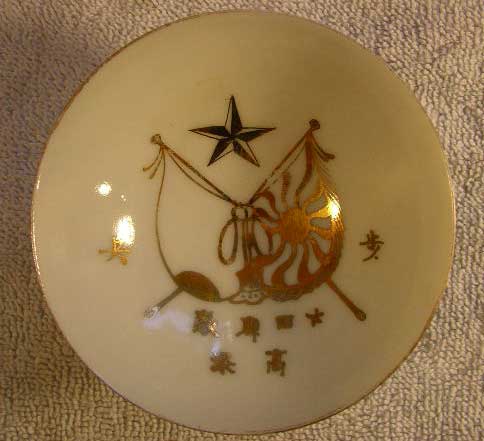
This next one is also large, about
94mm, and has the same crossed flag motif, but in colour this time. The four
characters in a vertical column at the top centre read ya-sen-ho-hei, or “field artillery”. The five characters in the
centre at the bottom between the staffs of the flags read from right to left: dai-ju-ni-ren-tai, or Regiment Number
12. The Twelfth Field Artillery Regiment came from
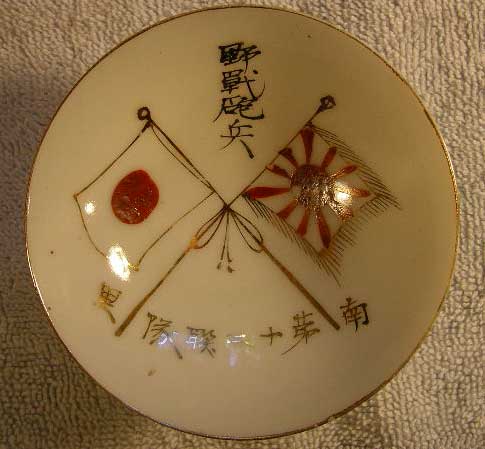
This is a smaller cup, 74mm in diameter, with
the common “shaded star above crossed flags” motif. The five characters across
the top are read from right to left. The first three are sei-haku-ri, which makes no sense to me. The last two on the left
are easy: ki-nen, or commemorative.
The four across the bottom read from right to left: ho-no-nana-ichi, or “infantry 71”, probably an indication of the 71st
Infantry Regiment.
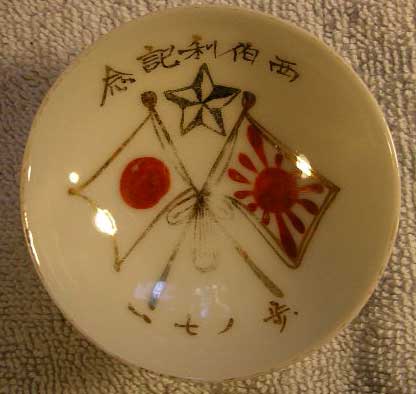
This cup has a maker’s
signature on the bottom. The two characters are read from top to bottom and
represent the surname Sueda.
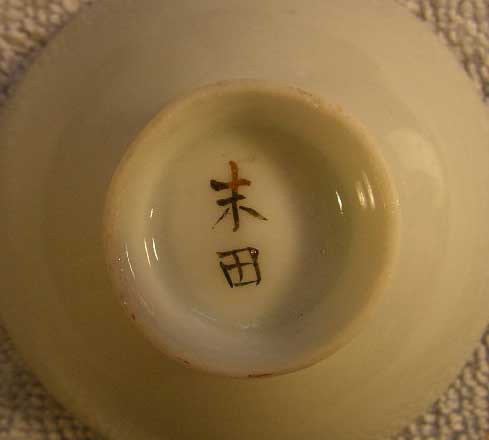
I think this one is especially
beautiful with its lavish use of gold leaf. It is 99mm in diameter, or almost
four inches. The symbol at the top looks like a rising sun, while the leaves at
the bottom are paulownia, a symbol of the Japanese imperial family. The two
characters in the little oval capsule at the far left say ki-nen, meaning “commemorative”. The seller told me it was a kempeitai (military police) cup, but
most of the calligraphy in the seven columns is illegible to me, so I’m not
sure. I’ll have to ask my Japanese friend and see if she can figure it out. The
only line I can read is the middle one. It seems to indicate ho-no-kyu, or Ninth Infantry (Regiment,
presumably). The Ninth Infantry Regiment came from

Here’s a cup I bet a lot of guys
were glad to get. The four characters across the top read tai-ei-ki-nen, or “Commemorating concluding one’s military
service”. It is a small cup, 67mm (2 5/8 inches) in diameter. I think this is
the size known as guinomi, or “quick
gulp”. My guess is that anyone who made it through their service would probably
want to knock back
quite a few of these tiny cups!
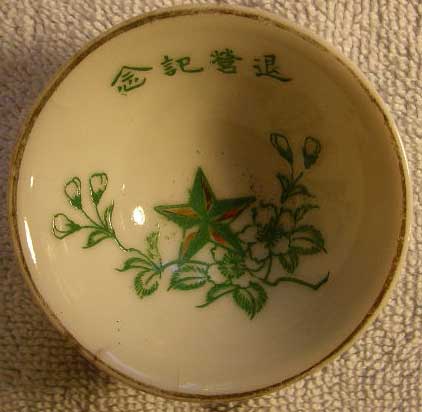
This one seems a little odd at first. The very
cursive calligraphy on the right and left is a mystery to me, but the writing on
the banner is quite legible. It says: roku-shu-kan-gen-eki-hei,
or “soldier who has completed six weeks’ active service”. I think this is
probably for completing a secondary call-up period of six weeks, rather than
six weeks of one’s main military service. The cup is 98mm in diameter and has
the ubiquitous pink cherry blossoms.
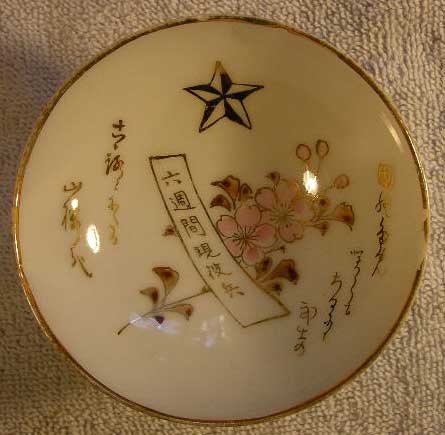
The bottom has the maker’s signature, Hiramatsu.
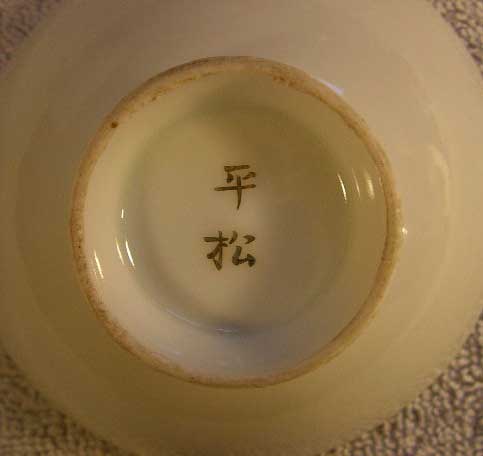
This next one is an example of what
is called a “helmet cup” (kabuto sakazuki
in Japanese) because it is shaped like a helmet, as you will see a little
further down. This style of cup is covered on pages 86-91 of the Dan King book referenced
at the bottom of this page. This one is quite small, about 56mm (2 3/16”) in
diameter. It was made to commemorate the 30th anniversary of the
Russo-Japanese War, which
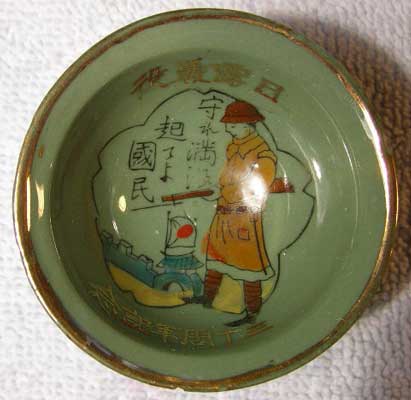
This close-up shows the “Russo-Japanese War”
caption a little more clearly.
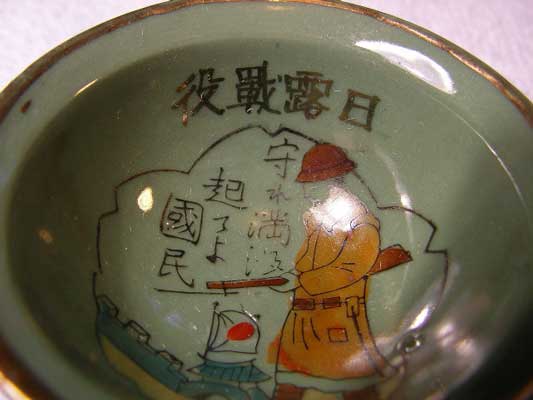
Here you can clearly see the reason why these
are called “helmet cups”. Note that it even has the Army star moulded in.
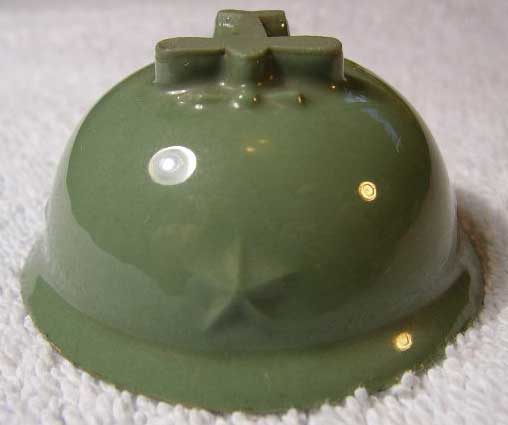
There is a faint trace of what may
be the character hara (field) in
gold, as well as four very faint characters pressed into the cup itself. The
first one on the right looks like oto
(sound) and the second one from the left looks like ari (is). I suspect this might be the maker’s name but I can’t make
it out. The yellow thing in the lower left corner is a pencil, which gives you
some idea of scale.
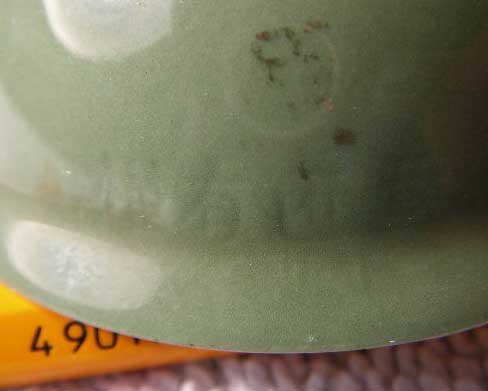
Here is the bottom. These cups
usually had some kind of design moulded into the base. Here it’s an airplane.
The gold leaf characters at the bottom read left to right and say Mura-ta
Futoshi, the soldier’s name.
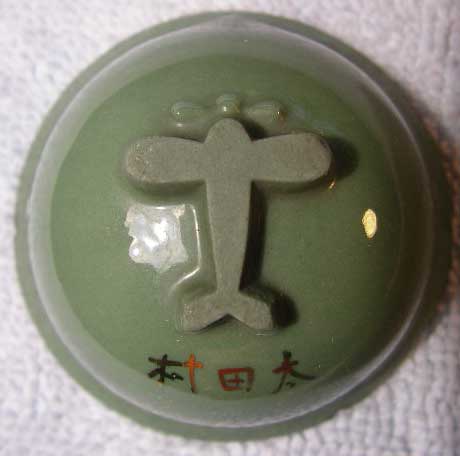
This is another helmet cup, but a very scarce one: it refers to the
Greater East Asian War, which was how the Japanese referred to the period from
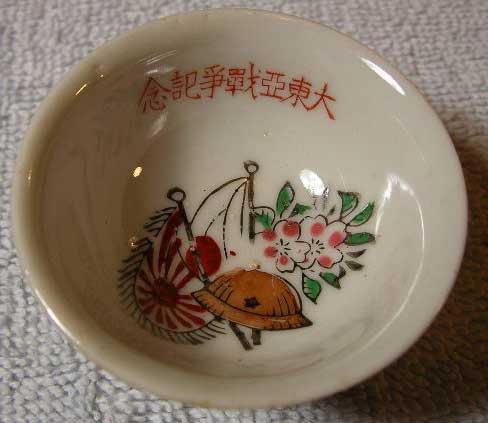
The bottom shows a propeller design.
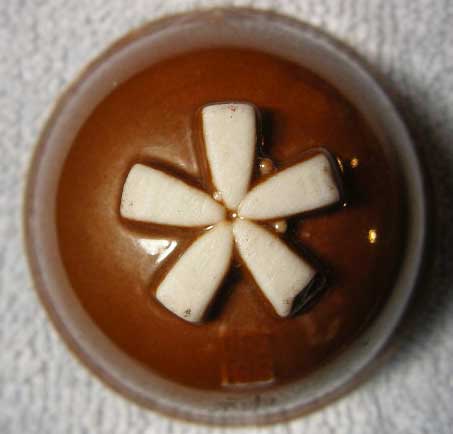
The soldier’s family name is in gold: Kaminaga. There is also something
molded into the cup between the propeller and the gold writing. I haven’t been
able to figure it out yet. The bottom part looks like 166.
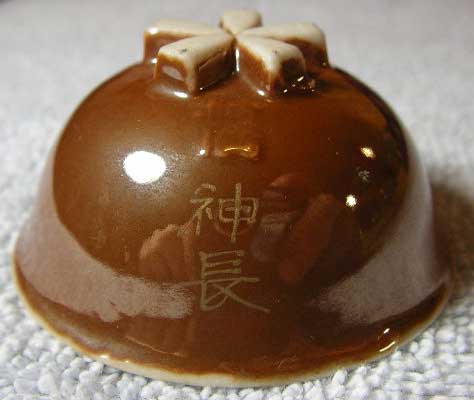
Although there is a lot of glare and
reflection in this photo, you can make out the star in the lower central part
of the photo.
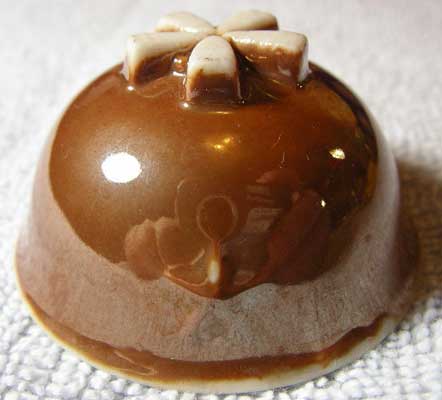
Here is another item with a Manchurian connection. This sake bottle is
about 147mm (5.75 inches) high. It is covered in a raised cherry blossom motif.

This close-up of the decoration on
the front of the bottle shows the Japanese military flag on the right and the
flagof
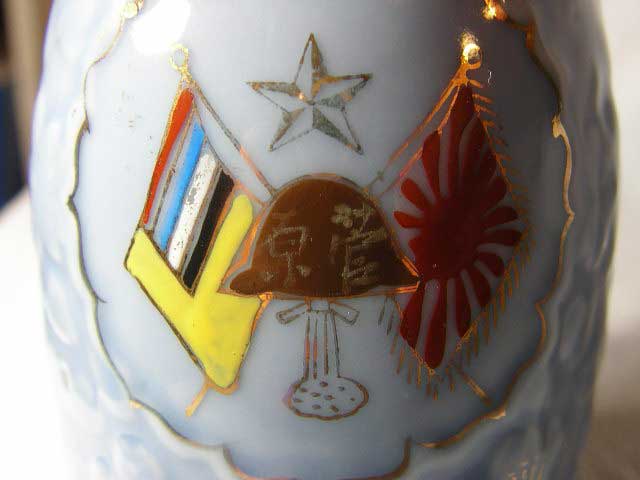
Here is the back of the bottle.
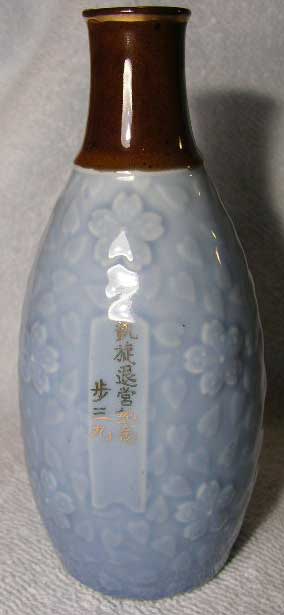
The inscription on the back is
clearer in this close-up. The right column says gai-sen-tai-ei-ki-nen, “commemorating completion of service and
triumphant return”. The left column says ho-san-kyu,
which is short for 39th Infantry Regiment. This regiment was based
in
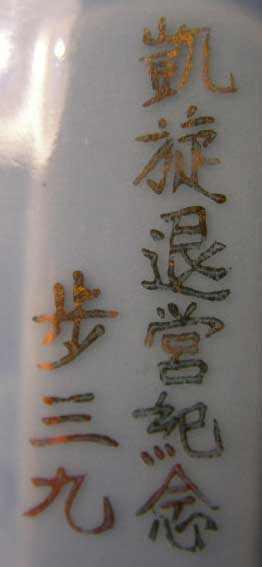
Quite a while after I got that
bottle I had a chance to pick up a bottle and a cup from the same regiment,
both named to a Mr. Morikawa. This bottle is 145mm (5 ½”) high.
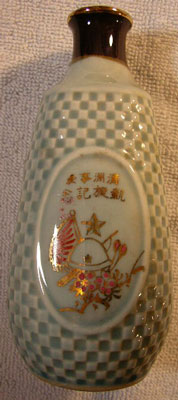
Here’s a close-up of the painted
part. The caption at the top says, from right to left: man-chu-ji-hen, [second line] gai-sen-ki-nen.
This means Manchurian Incident, In Commemoration of a Triumphant Return. The
Japanese referred to the long series of conflicts in
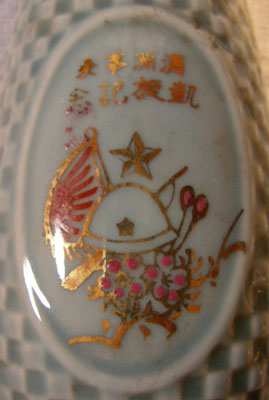
The back says “Infantry 39 [regiment] Morikawa”.
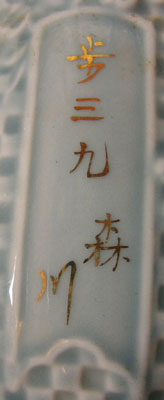
The bottom has something stamped into the
bottom. I think it is toku-sei, “custom-made”,
but it’s pretty hard to be sure.
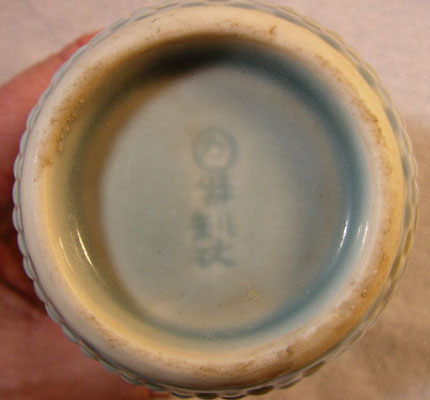
A close-up of the sakura (cherry
blossom) design.
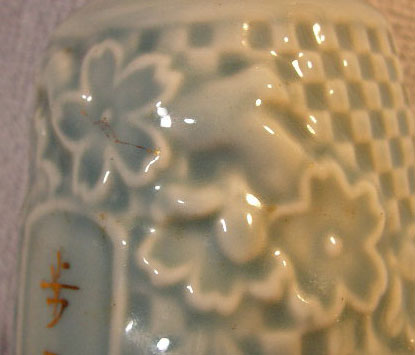
This is the cup that is named to Mr.
Morikawa of the 39th Infantry Regiment. It is 56mm (2 1/8 “) in
diameter and has the crossed flags of the Japanese military on the right and
the puppet state of
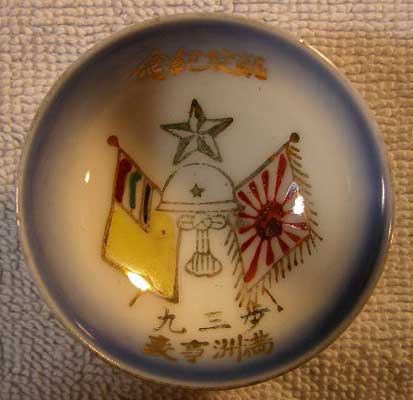
The gold painted letters at the top read from
right to left: gai-sen-ki-nen, “commemorating
a triumphant return”.
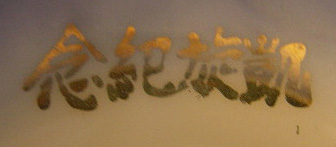
The bottom say ho-san-kyu (Infantry 39 [Regiment]), man-shu-ji-hen (Manchurian Incident).
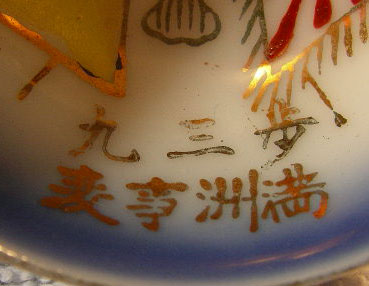
The bottom has the name Morikawa in gold
characters.
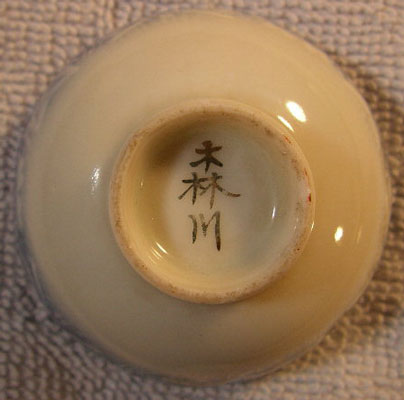
This one is very pretty from the
side. The design is, from left to right, the Army star, the hinomaru (“meatball”) flag, the military
flag and a sakura (cherry) blossom.
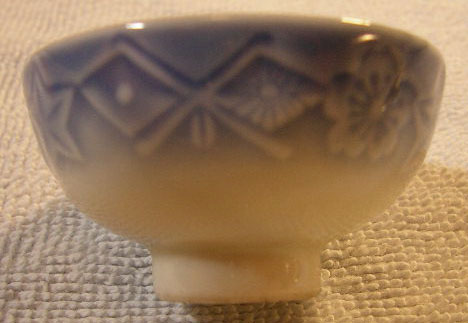
Another neat thing about this cup,
besides the name matching the bottle, is that is has the original box. The box
is 65mm (2 ½”) square by 35mm (1 3/8 “) high and made of light cardboard with a
paper covering glued on to rather unconvincingly simulate wood.
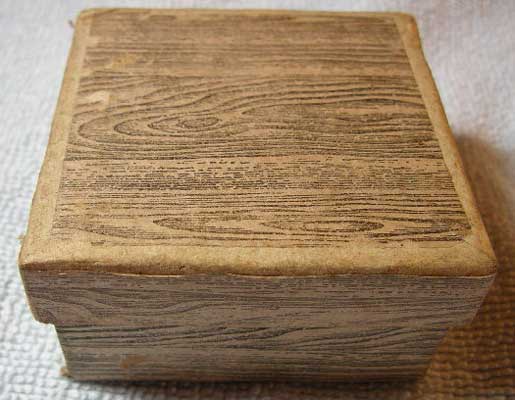
Here is the cup in the box.
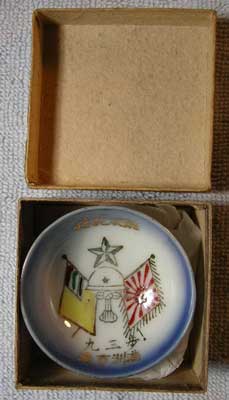
This cup is really old. It
commemorates the Russo-Japanese War of 1904-05, when
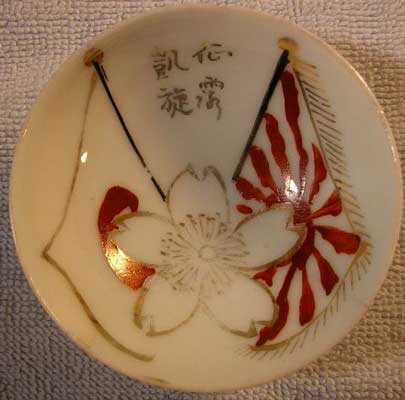
Here’s a close-up of the characters.
They read upper right, lower right, upper left, lower left: sei-ro-gai-sen, “triumphant return from
service against
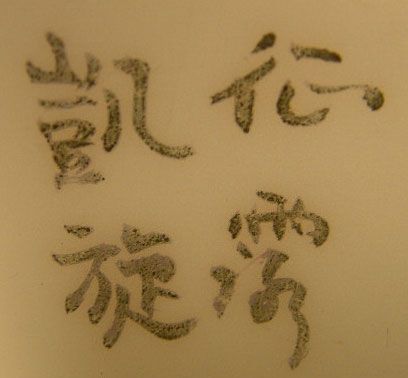
The bottom is very plain. The industry was just
getting started at that point.
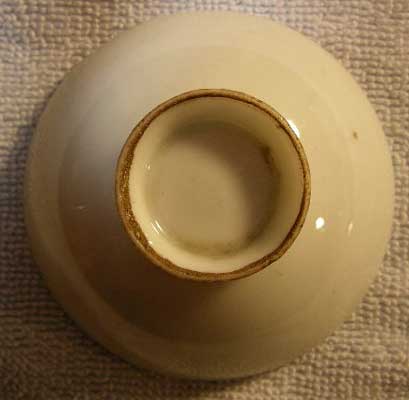
This one commemorates the group flag
of the youth association that was formed around 1915 to help instil martial and
nationalist views in
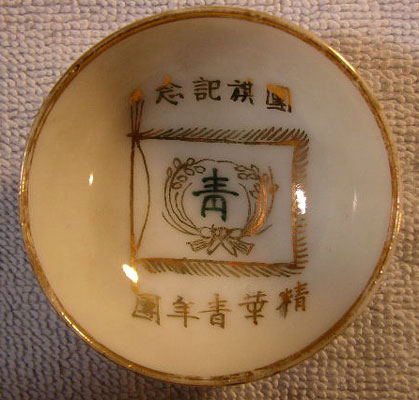
The top characters say, from right to left, dan-ki-ki-nen: commemorating the group
flag.
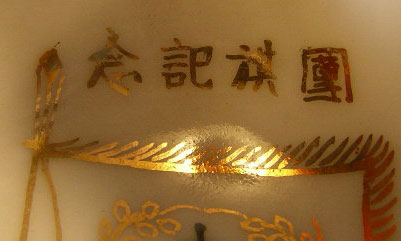
The bottom says (L-R): sei-kaku-sei-nen-dan, or spiritual reform youth group.
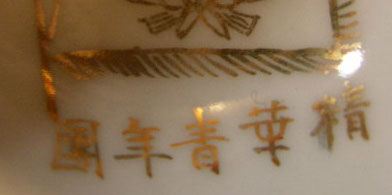
The bottom is fairly plain although there is a
neat swirl in the centre.
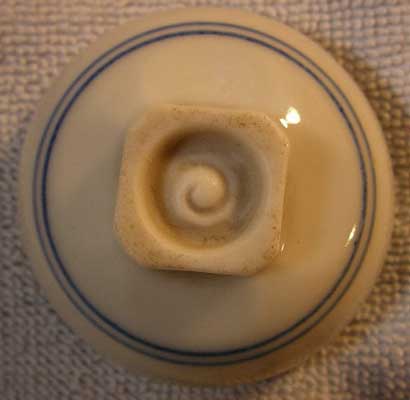
If you would like to find out more
about Japanese military sake cups and bottles, check out the new (2004) book by
Dan King referred to above. The title is Japanese
Military Sake Cups 1894-1945, and it is published by Schiffer Publishing. I
would have liked a little more text in this book, but the illustrations are
great and it’s the only thing I know of on the topic, at least in English.
There is apparently another book by Richard Fuller, but I haven’t seen it. Here
is a link to Schiffer’s site where you can buy the Dan King book:
Schiffer has been coming out with
some great books on Japanese military topics, including uniforms and pistols.
They are all beautiful as well as well done.
To return
to “Other Japanese Militaria”, please click here: Nambu World: Other
Japanese Militaria
To return
to the home page, please click here: Nambu World: Teri’s WWII Japanese
Handgun Website
Last updated: November 15, 2004. All contents
are copyright Teri unless otherwise specified and may not be used elsewhere in
any form without prior permission.